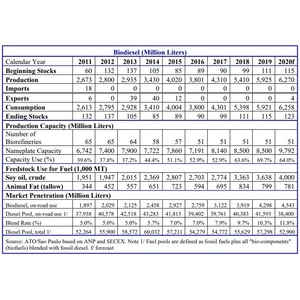Report: Brazilian biodiesel production to increase 6% in 2020

September 21, 2020
BY Erin Krueger
Brazilian biodiesel production is expected to reach 6.27 billion liters (1.66 billion gallons) this year, up 6 percent when compared to 2019, according to report recently filed with the USDA Foreign Agricultural Service’s Global Agricultural Information Network.
According to the report, Brazil has not imported any biodiesel since 2011 and is not expected to do so in 2020. Exports of the fuel are expected at 4 million liters this year following four consecutive years of zero biodiesel exports.
Brazil’s consumption of biodiesel is expected at 6.258 billion liters this year, up form 5.921 billion liters in 2019.
The report indicates that Brazil currently has 51 operational biodiesel plants, a number that has held steady since 2016. Biodiesel capacity, however, is expected to reach 9.792 billion liters, up from 8.5 billion liters in 2019. The country’s biodiesel plants are expected to operate at 64 percent capacity this year, up from 69.7 percent in 2020.
Advertisement
Advertisement
Brazil’s biodiesel plants are expected to consume 4 million tons of soy oil this year, along with 781,000 tons of animal fat. Last year, the plants took in 3.638 million tons of soy oil and 799 tons of animal fat.
A full copy of the report can be downloaded from the USDA FAS GAIN website.
Advertisement
Advertisement
Related Stories
The USDA significantly increased its estimate for 2025-’26 soybean oil use in biofuel production in its latest World Agricultural Supply and Demand Estimates report, released July 11. The outlook for soybean production was revised down.
U.S. fuel ethanol capacity fell slightly in April, while biodiesel and renewable diesel capacity held steady, according to data released by the U.S. EIA on June 30. Feedstock consumption was down when compared to the previous month.
The U.S. EPA on July 8 hosted virtual public hearing to gather input on the agency’s recently released proposed rule to set 2026 and 2027 RFS RVOs. Members of the biofuel industry were among those to offer testimony during the event.
The USDA’s Risk Management Agency is implementing multiple changes to the Camelina pilot insurance program for the 2026 and succeeding crop years. The changes will expand coverage options and provide greater flexibility for producers.
The USDA’s National Agricultural Statistics Service on June 30 released its annual Acreage report, estimating that 83.4 million acres of soybeans have been planted in the U.S. this year, down 4% when compared to 2024.
Upcoming Events










